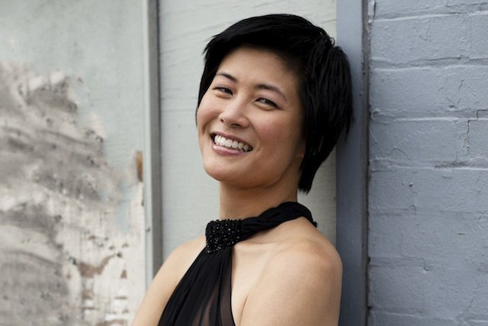The Washington Times
By Terry Ponick
July 25, 2012
original
link
Violinist Jennifer Koh's outstanding J.S. Bach

Virtuoso violinist Jennifer Koh. (Credit: Chad Batka.)
CASTLETON, Va., July 25, 2012 – Sunday evening, Jennifer Koh presented an extraordinary all-Bach recital at Castleton’s more intimate small Festival Theatre venue.
Extraordinary is actually an understatement. Somewhere in the early 1700s, Bach composed a set of three sonatas and three partitas for unaccompanied violin apparently for his own personal satisfaction. Of surpassing technical difficulty and requiring the highest level of virtuosity to play, they were never actually performed in public during the composer’s lifetime, even though he himself was known as an accomplished violinist.
Rarely, these six works are performed in a single concert, but only by those violinists daring enough to expose themselves to ruthless scrutiny of their style and skill. But that’s precisely what Ms. Koh did Sunday in a daring recital seemingly designed from the ground up for violin connoisseurs.
This reviewer confesses to being more of a piano fan than a violin fan, probably because he’s become more familiar with the piano repertoire over the years. As a much larger and structurally more complex instrument, the piano, on a point-for-point basis, can present a larger dynamic array of sounds and effects than the much smaller, much simpler violin.
That said, a real violin virtuoso can unveil a broader array of effects than might be readily apparent. And that simple fact, along with breathtaking passion, nuance, and virtuostic fearlessness is what made Ms. Koh’s Sunday recital special. Throughout her strenuous three-hour concert, Ms. Koh unveiled J.S. Bach as a surprisingly passionate, almost Romantic virtuoso violinist-composer while also revealing herself as one of the most cerebral, talented, accomplished, and daring violinists of her generation.
All the elements that have contributed to Bach’s fame and popularity since the revival of his music in the 19th century are present in these violin works: complex fugues executed with multiple voices analogous to organ fugues but different in context; rapid, presto passages wickedly difficult to execute without fumbling; rhythmic and contrapuntal complexity that is at times surpassingly difficult to see as well as to execute; sudden shifts in nuance and mood.
In addition, lest we forget, is the supreme challenge of performing these most athletic of violin pieces in one concert without the safety net of an onsite trainer, hot tub, and ice packs in between pieces. Frankly, the overpraised young international athletes we’ll see shortly during the televised 2012 London Summer Olympics won’t measure up to the athleticism and sheer physical stamina Ms. Koh displayed at her recital.
This is a concert that’s tough to explicate in a short review. So many things were going on, so many of them involving intricate technical and interpretive points, that it’s hard to know where to begin. Each of the sonatas and partitas in Sunday’s concert are multiple movement affairs, featuring standard sequences of movements (in the sonatas) and eclectic combinations of dance movements, slow and fast, in the partitas.
Perhaps the highlight of the concert, however—its centerpiece as it were—is the famous Chaconne that caps Bach’s “Partita No. 2” in D-minor. Portions of it are well known, popularized in arrangements of the original and in “theme and variation” compositions penned by other musicians. But Ms. Koh played the whole fifteen-minute monster here, revealing to herself and to the audience what was arguably the musical and religious universe that lived inside J.S. Bach’s complex and ordered head.
From a technical standpoint, Bach threw everything into this piece but the proverbial kitchen sinks. Independent and simultaneous voices, wildly variable speeds, violent mood shifts, wicked and ruthless runs—you name it, it’s in here. But the Chaconne is not just an empty party-piece meant to show off a soloist’s virtuosity, although it certainly does that. Rather, Bach is using every imaginable tool in his musical kit to describe his world, his feelings, his passions, and his spiritual beliefs all in one relatively short movement. Richard Strauss, in another era, might have called the Chaconne a “tone poem,” so exquisitely does it suggest a purely spiritual realm.
Ms. Koh reached back and re-discovered the universe in her exquisite interpretation. With supreme confidence, and yet, oddly, with a humility borne out of the difficulty of her art, she invited the audience in to Bach’s world and her own as well. Her performance of the Chaconne—and indeed of everything else—was at once dazzling and intimate. As the performing artist, she invited every member of the audience inside the tent to see something very special that perhaps they’d never seen before nor were likely to see again.
Ms. Koh’s entire Bach recital came with great expectations on the part of the audience. She’s been performing this recital at selected venues so its reputation preceded this performance. But oftentimes expectations are raised only to be dashed by the reality of the performance. This recital, however, exceeded any advance notice. It was one of those events that a sports fan might describe as something where “you shoulda been there.”
Hopefully, in an era in which recording studios seem increasingly loath to cut classical CDs, someone can be found who’ll support a complete recording of Ms. Koh’s program. It’s not likely to be a best seller in this “American Idol” obsessed world. But connoisseurs of classical music, virtuoso violinists, and the works of J.S. Bach will avidly order this hypothetical disc, regarding it as a key element of their music library.
Meanwhile, we have our memories of a beautiful summer evening at Castleton where something quite wonderful happened. Brava to Ms. Koh, and thanks for the memories.
Rating: **** (Four stars.)
Copyright ©2012 The Washington Times
© Jennifer Koh, All Rights Reserved. Photography by Juergen Frank. Site by ycArt design studio